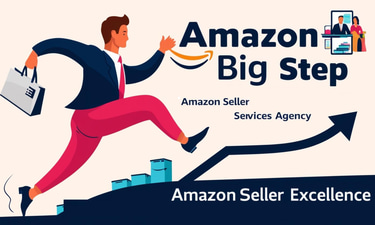The Amazon Game Has Changed — Here’s How Smart Sellers Are Winning in 2025
Selling on Amazon used to be simple. You listed your product, added a few keywords, ran a couple of ads, and boom — sales rolled in. But those days are gone. Today’s Amazon marketplace is a battlefield powered by algorithms, data, and strategy. It rewards brands that understand how to play the long game — and quietly buries the rest. The good news? The rules of the game can still be learned, and once you understand them, Amazon can become the single biggest growth driver your brand has ever seen. This article will walk you through what’s working right now on Amazon in 2025, the common mistakes even experienced sellers still make, and how to build a sustainable, scalable presence that stands out no matter how crowded the competition gets.
Amazon Big Step Team
10/13/20255 min read


1. The Harsh Truth: Visibility Is Everything
If your product isn’t showing up on page one, it might as well not exist.
That’s the first rule of Amazon success — and also the biggest challenge most sellers face.
Amazon’s search algorithm (A10 and its ongoing updates) is constantly evolving, weighing everything from your product title and conversion rate to backend keywords, price competitiveness, and even how often customers return your items.
But here’s what hasn’t changed: visibility still depends on relevance and performance.
Relevance is built through smart keyword research, optimized content, and category accuracy.
Performance comes from sales velocity, review quality, and click-through rates.
The top-performing brands on Amazon don’t just guess which keywords matter — they study buyer intent and design listings that match it perfectly.
Example: Instead of simply writing “Bluetooth Speaker,” a smart seller studies search data to find that buyers are actually typing “portable waterproof Bluetooth speaker for beach.”
That difference in keyword depth is what turns browsers into buyers.
2. Why Most Sellers Waste Money on Ads
Amazon PPC (Pay-Per-Click) is powerful — but it’s also one of the fastest ways to lose money if not handled strategically.
Many sellers think increasing their ad budget equals more sales. In reality, without understanding campaign structure, targeting, and keyword match types, they’re just feeding Amazon’s ad machine.
In 2025, the smartest Amazon advertisers are shifting focus from volume to efficiency.
They prioritize:
Precision targeting (long-tail keywords with buyer intent)
Dynamic bid control (adjusting by time of day, device, and placement)
Data layering — combining PPC performance with organic ranking to guide keyword decisions
The result? Lower ACoS (Advertising Cost of Sales) and a higher ROI without having to spend more.
One trick many successful sellers use is creating synergy between PPC and SEO — using ad data to identify which keywords convert best, then building them naturally into product listings.
That way, every dollar spent on ads helps boost organic ranking long-term.
3. The Secret Weapon: Content That Sells Without Selling
Amazon is no longer just a place to buy — it’s a place to experience products.
Shoppers expect rich visuals, emotional storytelling, and trust-building content before they ever click “Buy Now.”
That’s why A+ Content (Enhanced Brand Content) and Brand Story sections have become vital.
But too many brands treat these sections as decoration instead of conversion tools.
High-performing listings on Amazon typically use:
Clean, mobile-optimized imagery showing real use cases
Comparison charts that clearly differentiate features
Benefit-focused bullet points (“Save time in your kitchen” instead of “Stainless steel blade”)
Authentic storytelling that builds brand personality
The goal is simple: sell through understanding, not persuasion.
A buyer who feels connected to your product doesn’t need a discount — they need reassurance.
And when your listing gives that reassurance, your conversion rates naturally rise, which improves your ranking, which brings in more traffic — the classic Amazon flywheel.
4. Reviews: The Hidden Currency of Amazon
No matter how great your product is, if you don’t have social proof, you’re invisible.
Reviews are the heartbeat of Amazon’s ecosystem. They influence rankings, conversion rates, and even PPC performance.
But reviews today are harder to earn — and easier to lose.
The focus has shifted from “getting more reviews” to getting the right kind of reviews.
That means:
Delivering consistent product quality to avoid negative feedback
Encouraging post-purchase engagement (follow-up emails or inserts)
Responding professionally to negative reviews to protect your brand image
One overlooked metric is review velocity — how consistently new reviews come in. A steady flow of reviews signals to Amazon that your product remains relevant and active, boosting its organic visibility.
So instead of chasing 1,000 reviews overnight, smart sellers build a sustainable review strategy aligned with their order volume.
5. The Power of Brand Registry and Data Insight
Amazon is increasingly rewarding brands, not just sellers.
If you haven’t registered your brand through Amazon Brand Registry yet, you’re missing out on powerful tools like:
A+ Content and Brand Story features
Sponsored Brand ads and video campaigns
Brand Analytics for keyword and competitor insights
Protection against counterfeit listings
But perhaps the biggest advantage of being a registered brand is data access.
Amazon’s Brand Analytics lets you peek behind the curtain — understanding which keywords bring clicks, what competitors are doing, and where your traffic actually converts.
This data isn’t just useful; it’s transformational.
It allows you to refine your strategy continuously, turning guesswork into predictable growth.
6. Common Mistakes Even Experienced Sellers Make
Let’s face it — Amazon success takes discipline.
Even established brands fall into these traps:
Focusing on traffic instead of conversions. High clicks mean nothing if your listings don’t convert.
Overpricing early. A high price tag can kill initial momentum; smart sellers start competitive, then scale.
Ignoring backend optimization. Your backend keywords, attributes, and browse nodes are quiet ranking boosters.
Neglecting account health. Late shipments, IP complaints, or inconsistent inventory can drop your visibility overnight.
Avoiding these mistakes isn’t complicated — it just requires awareness and consistent maintenance.
7. Building a Scalable Amazon Business in 2025
Sustainability on Amazon doesn’t come from “hacks” — it comes from systems.
Here’s what every growing brand should focus on:
a) Diversified Traffic
Don’t rely solely on Amazon traffic. Bring audiences from your website, email lists, and social media. External traffic boosts organic rank and brand credibility.
b) Smart Automation
Tools for repricing, review requests, and inventory forecasting save time and prevent costly errors.
c) Real Brand Building
Amazon is your storefront, not your identity. Use packaging, storytelling, and consistent visuals to make buyers remember you, not just your product.
d) Continuous Optimization
What worked last month might not work next month. Always test — from titles to ad placements — and track performance metrics closely.
Amazon is data-driven, and the sellers who treat it that way are the ones who win big.
8. The New Edge: Strategic Partnership
Managing all these moving parts alone can be overwhelming, especially when you’re juggling product development, supply chain, and customer service.
That’s why many brands today choose to collaborate with specialized Amazon service providers — not to hand off control, but to scale faster and smarter.
An experienced Amazon partner brings structure, analytics, and tested systems. They can see what’s not visible at first glance — patterns in keyword shifts, ad fatigue, or algorithmic triggers that can make or break a listing.
At Amazon Big Step, for instance, our focus isn’t on offering “one-size-fits-all” packages. It’s on understanding each brand’s stage, identifying gaps, and building a custom strategy that blends organic and paid growth.
We believe every seller deserves to know why something works — not just that it does.
Because when you understand your data, you own your success.
9. The Future of Selling on Amazon
Looking ahead, Amazon is becoming even more competitive — but also more opportunity-rich for brands that adapt.
AI-powered listing tools, advanced analytics, and growing demand for authenticity are changing the game.
The winners will be the ones who:
Build genuine brand stories
Leverage customer data to improve products
Master both paid and organic growth loops
Stay compliant while staying creative
Amazon rewards consistency, not shortcuts.
The brands that embrace continuous learning, testing, and strategic refinement will keep their edge long after others fade.
Final Thoughts
Selling on Amazon in 2025 isn’t easy — but it’s still one of the most powerful business opportunities in the world.
It demands attention, creativity, and a willingness to evolve.
Whether you’re a solo seller just starting out or an established brand looking to scale, the key lies in understanding the system — not fighting it.
The marketplace doesn’t need more sellers; it needs better strategies.
So take a step back, analyze your current performance, and ask yourself:
Are my listings truly optimized for conversion?
Am I using data, or just guessing?
Do my ads feed long-term growth or short-term traffic?
Once you start answering these questions honestly, your direction becomes clear — and your growth unstoppable.
Amazon Big Step was built on that philosophy — that growth isn’t luck, it’s strategy.
And every brand, big or small, deserves the chance to take its next big step forward
Expertise
Your partner for Amazon growth and success.
Services
Insights
connect@amazonbigstep.com
+1 (859)4182348
© 2025. All rights reserved.
